Criminology Learning Journal: Victims, Police & Collaboration
VerifiedAdded on 2023/06/09
|7
|2136
|500
Journal and Reflective Writing
AI Summary
This assignment presents a learning journal covering key aspects of criminology. It includes reflections on victimology, examining the definition of victims, the role of government policies, and different approaches to victimology. Furthermore, it delves into the crucial role of the police within the criminal justice system, focusing on maintaining discipline, preventing crime, and upholding human rights. Finally, the journal explores collaborative work with other law enforcement agencies, emphasizing the importance of interagency partnerships and coordinated efforts in addressing traffic accidents and threats to public safety. The journal entries include personal opinions, changes in thinking, and potential future actions based on the learning experiences, concluding with relevant references and overall conclusions for each topic.
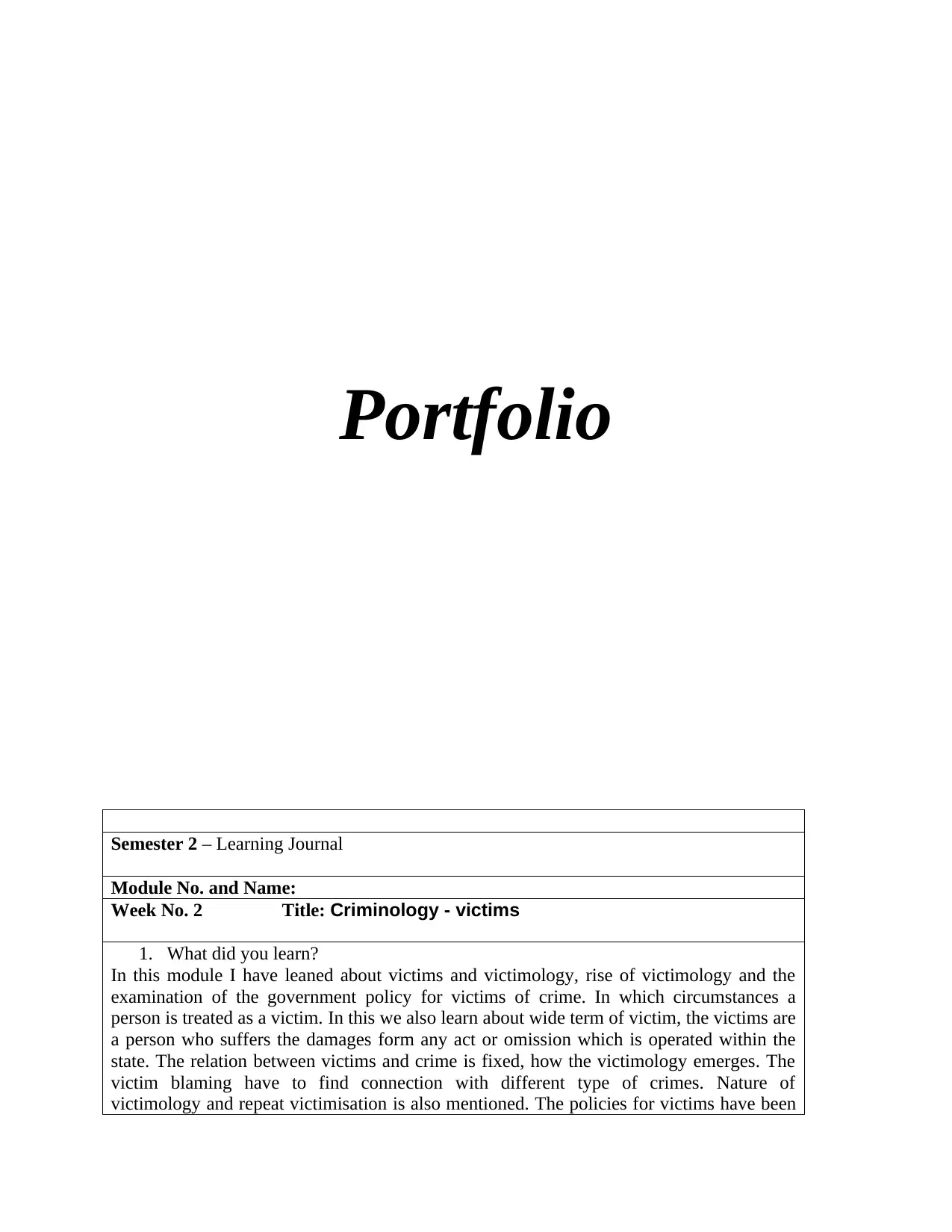
Portfolio
Semester 2 – Learning Journal
Module No. and Name:
Week No. 2 Title: Criminology - victims
1. What did you learn?
In this module I have leaned about victims and victimology, rise of victimology and the
examination of the government policy for victims of crime. In which circumstances a
person is treated as a victim. In this we also learn about wide term of victim, the victims are
a person who suffers the damages form any act or omission which is operated within the
state. The relation between victims and crime is fixed, how the victimology emerges. The
victim blaming have to find connection with different type of crimes. Nature of
victimology and repeat victimisation is also mentioned. The policies for victims have been
Semester 2 – Learning Journal
Module No. and Name:
Week No. 2 Title: Criminology - victims
1. What did you learn?
In this module I have leaned about victims and victimology, rise of victimology and the
examination of the government policy for victims of crime. In which circumstances a
person is treated as a victim. In this we also learn about wide term of victim, the victims are
a person who suffers the damages form any act or omission which is operated within the
state. The relation between victims and crime is fixed, how the victimology emerges. The
victim blaming have to find connection with different type of crimes. Nature of
victimology and repeat victimisation is also mentioned. The policies for victims have been
Paraphrase This Document
Need a fresh take? Get an instant paraphrase of this document with our AI Paraphraser
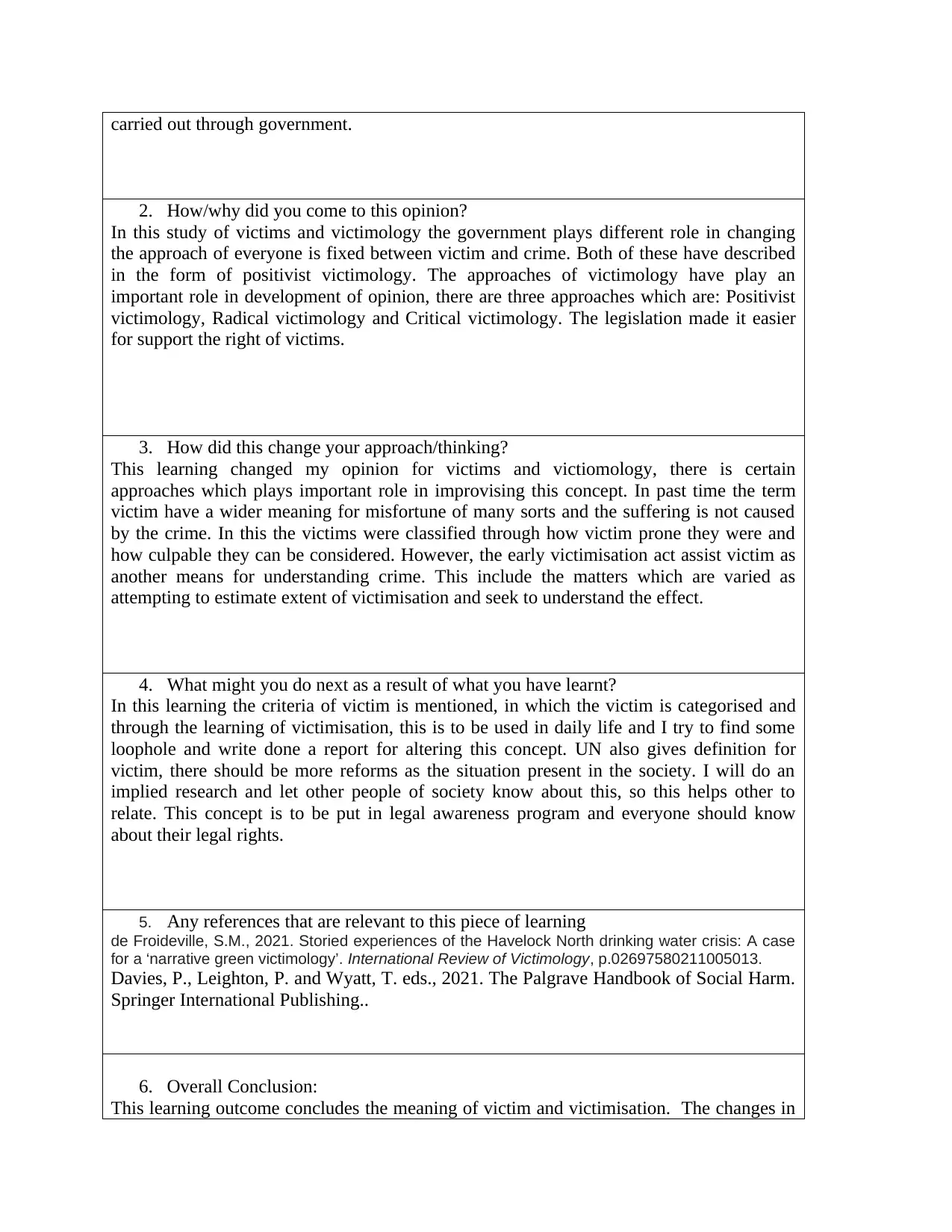
carried out through government.
2. How/why did you come to this opinion?
In this study of victims and victimology the government plays different role in changing
the approach of everyone is fixed between victim and crime. Both of these have described
in the form of positivist victimology. The approaches of victimology have play an
important role in development of opinion, there are three approaches which are: Positivist
victimology, Radical victimology and Critical victimology. The legislation made it easier
for support the right of victims.
3. How did this change your approach/thinking?
This learning changed my opinion for victims and victiomology, there is certain
approaches which plays important role in improvising this concept. In past time the term
victim have a wider meaning for misfortune of many sorts and the suffering is not caused
by the crime. In this the victims were classified through how victim prone they were and
how culpable they can be considered. However, the early victimisation act assist victim as
another means for understanding crime. This include the matters which are varied as
attempting to estimate extent of victimisation and seek to understand the effect.
4. What might you do next as a result of what you have learnt?
In this learning the criteria of victim is mentioned, in which the victim is categorised and
through the learning of victimisation, this is to be used in daily life and I try to find some
loophole and write done a report for altering this concept. UN also gives definition for
victim, there should be more reforms as the situation present in the society. I will do an
implied research and let other people of society know about this, so this helps other to
relate. This concept is to be put in legal awareness program and everyone should know
about their legal rights.
5. Any references that are relevant to this piece of learning
de Froideville, S.M., 2021. Storied experiences of the Havelock North drinking water crisis: A case
for a ‘narrative green victimology’. International Review of Victimology, p.02697580211005013.
Davies, P., Leighton, P. and Wyatt, T. eds., 2021. The Palgrave Handbook of Social Harm.
Springer International Publishing..
6. Overall Conclusion:
This learning outcome concludes the meaning of victim and victimisation. The changes in
2. How/why did you come to this opinion?
In this study of victims and victimology the government plays different role in changing
the approach of everyone is fixed between victim and crime. Both of these have described
in the form of positivist victimology. The approaches of victimology have play an
important role in development of opinion, there are three approaches which are: Positivist
victimology, Radical victimology and Critical victimology. The legislation made it easier
for support the right of victims.
3. How did this change your approach/thinking?
This learning changed my opinion for victims and victiomology, there is certain
approaches which plays important role in improvising this concept. In past time the term
victim have a wider meaning for misfortune of many sorts and the suffering is not caused
by the crime. In this the victims were classified through how victim prone they were and
how culpable they can be considered. However, the early victimisation act assist victim as
another means for understanding crime. This include the matters which are varied as
attempting to estimate extent of victimisation and seek to understand the effect.
4. What might you do next as a result of what you have learnt?
In this learning the criteria of victim is mentioned, in which the victim is categorised and
through the learning of victimisation, this is to be used in daily life and I try to find some
loophole and write done a report for altering this concept. UN also gives definition for
victim, there should be more reforms as the situation present in the society. I will do an
implied research and let other people of society know about this, so this helps other to
relate. This concept is to be put in legal awareness program and everyone should know
about their legal rights.
5. Any references that are relevant to this piece of learning
de Froideville, S.M., 2021. Storied experiences of the Havelock North drinking water crisis: A case
for a ‘narrative green victimology’. International Review of Victimology, p.02697580211005013.
Davies, P., Leighton, P. and Wyatt, T. eds., 2021. The Palgrave Handbook of Social Harm.
Springer International Publishing..
6. Overall Conclusion:
This learning outcome concludes the meaning of victim and victimisation. The changes in

victimology is being mentioned in this, the major factors which contributes for rising
public profile for victim and issues of victimisation is there. Victim blaming is still there
and found in connection with different form of crime. The early victimisation work is used
as the another means of understanding crime. Repeat victimisation is one of the important
facet for uneven social and geographical distribution of crime. This also includes rights of
victims and have charter published for this in the year 1990 and 1996 and in year 2002 the
government publishes a white paper justice for all which state for rebalance of system in
favour of victims.
public profile for victim and issues of victimisation is there. Victim blaming is still there
and found in connection with different form of crime. The early victimisation work is used
as the another means of understanding crime. Repeat victimisation is one of the important
facet for uneven social and geographical distribution of crime. This also includes rights of
victims and have charter published for this in the year 1990 and 1996 and in year 2002 the
government publishes a white paper justice for all which state for rebalance of system in
favour of victims.
⊘ This is a preview!⊘
Do you want full access?
Subscribe today to unlock all pages.

Trusted by 1+ million students worldwide
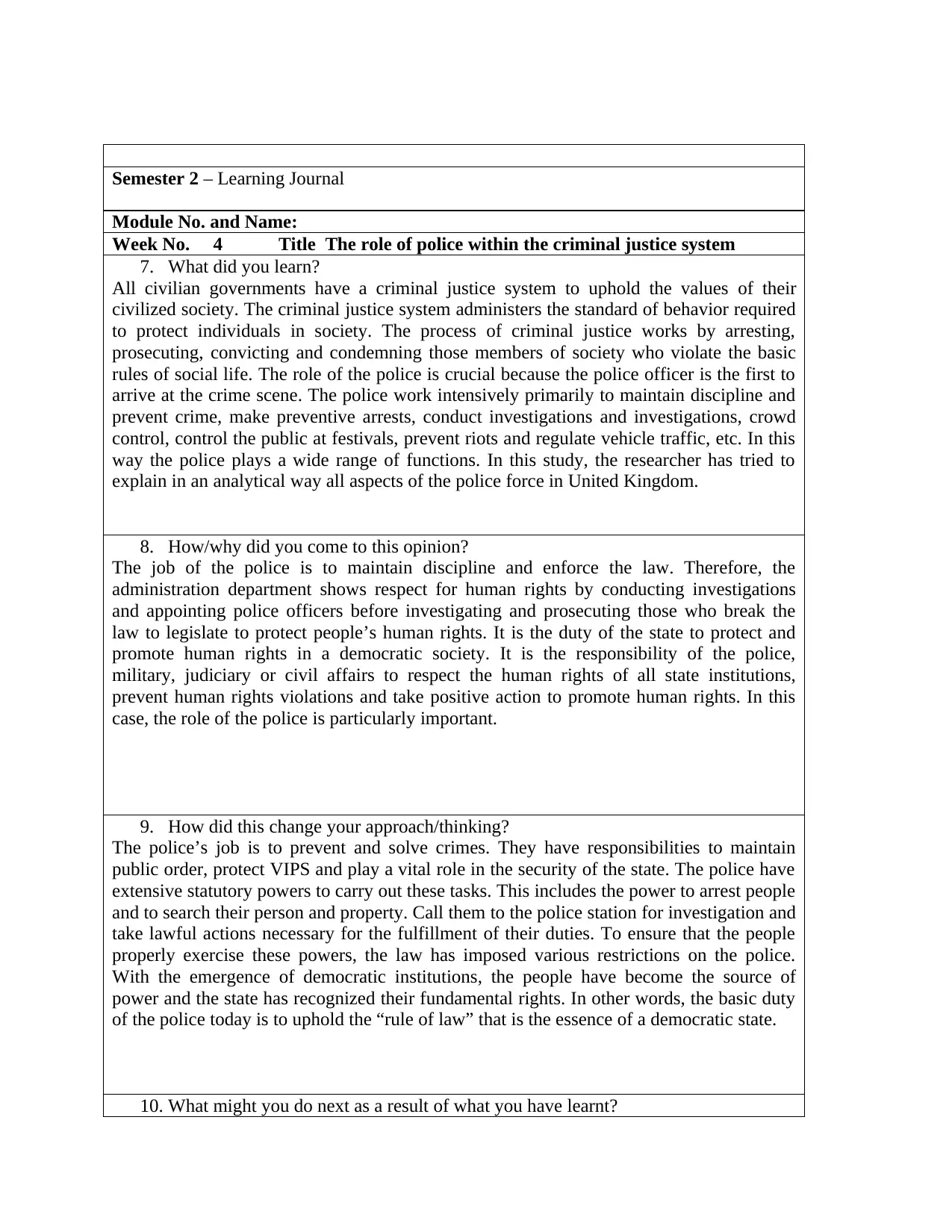
Semester 2 – Learning Journal
Module No. and Name:
Week No. 4 Title The role of police within the criminal justice system
7. What did you learn?
All civilian governments have a criminal justice system to uphold the values of their
civilized society. The criminal justice system administers the standard of behavior required
to protect individuals in society. The process of criminal justice works by arresting,
prosecuting, convicting and condemning those members of society who violate the basic
rules of social life. The role of the police is crucial because the police officer is the first to
arrive at the crime scene. The police work intensively primarily to maintain discipline and
prevent crime, make preventive arrests, conduct investigations and investigations, crowd
control, control the public at festivals, prevent riots and regulate vehicle traffic, etc. In this
way the police plays a wide range of functions. In this study, the researcher has tried to
explain in an analytical way all aspects of the police force in United Kingdom.
8. How/why did you come to this opinion?
The job of the police is to maintain discipline and enforce the law. Therefore, the
administration department shows respect for human rights by conducting investigations
and appointing police officers before investigating and prosecuting those who break the
law to legislate to protect people’s human rights. It is the duty of the state to protect and
promote human rights in a democratic society. It is the responsibility of the police,
military, judiciary or civil affairs to respect the human rights of all state institutions,
prevent human rights violations and take positive action to promote human rights. In this
case, the role of the police is particularly important.
9. How did this change your approach/thinking?
The police’s job is to prevent and solve crimes. They have responsibilities to maintain
public order, protect VIPS and play a vital role in the security of the state. The police have
extensive statutory powers to carry out these tasks. This includes the power to arrest people
and to search their person and property. Call them to the police station for investigation and
take lawful actions necessary for the fulfillment of their duties. To ensure that the people
properly exercise these powers, the law has imposed various restrictions on the police.
With the emergence of democratic institutions, the people have become the source of
power and the state has recognized their fundamental rights. In other words, the basic duty
of the police today is to uphold the “rule of law” that is the essence of a democratic state.
10. What might you do next as a result of what you have learnt?
Module No. and Name:
Week No. 4 Title The role of police within the criminal justice system
7. What did you learn?
All civilian governments have a criminal justice system to uphold the values of their
civilized society. The criminal justice system administers the standard of behavior required
to protect individuals in society. The process of criminal justice works by arresting,
prosecuting, convicting and condemning those members of society who violate the basic
rules of social life. The role of the police is crucial because the police officer is the first to
arrive at the crime scene. The police work intensively primarily to maintain discipline and
prevent crime, make preventive arrests, conduct investigations and investigations, crowd
control, control the public at festivals, prevent riots and regulate vehicle traffic, etc. In this
way the police plays a wide range of functions. In this study, the researcher has tried to
explain in an analytical way all aspects of the police force in United Kingdom.
8. How/why did you come to this opinion?
The job of the police is to maintain discipline and enforce the law. Therefore, the
administration department shows respect for human rights by conducting investigations
and appointing police officers before investigating and prosecuting those who break the
law to legislate to protect people’s human rights. It is the duty of the state to protect and
promote human rights in a democratic society. It is the responsibility of the police,
military, judiciary or civil affairs to respect the human rights of all state institutions,
prevent human rights violations and take positive action to promote human rights. In this
case, the role of the police is particularly important.
9. How did this change your approach/thinking?
The police’s job is to prevent and solve crimes. They have responsibilities to maintain
public order, protect VIPS and play a vital role in the security of the state. The police have
extensive statutory powers to carry out these tasks. This includes the power to arrest people
and to search their person and property. Call them to the police station for investigation and
take lawful actions necessary for the fulfillment of their duties. To ensure that the people
properly exercise these powers, the law has imposed various restrictions on the police.
With the emergence of democratic institutions, the people have become the source of
power and the state has recognized their fundamental rights. In other words, the basic duty
of the police today is to uphold the “rule of law” that is the essence of a democratic state.
10. What might you do next as a result of what you have learnt?
Paraphrase This Document
Need a fresh take? Get an instant paraphrase of this document with our AI Paraphraser
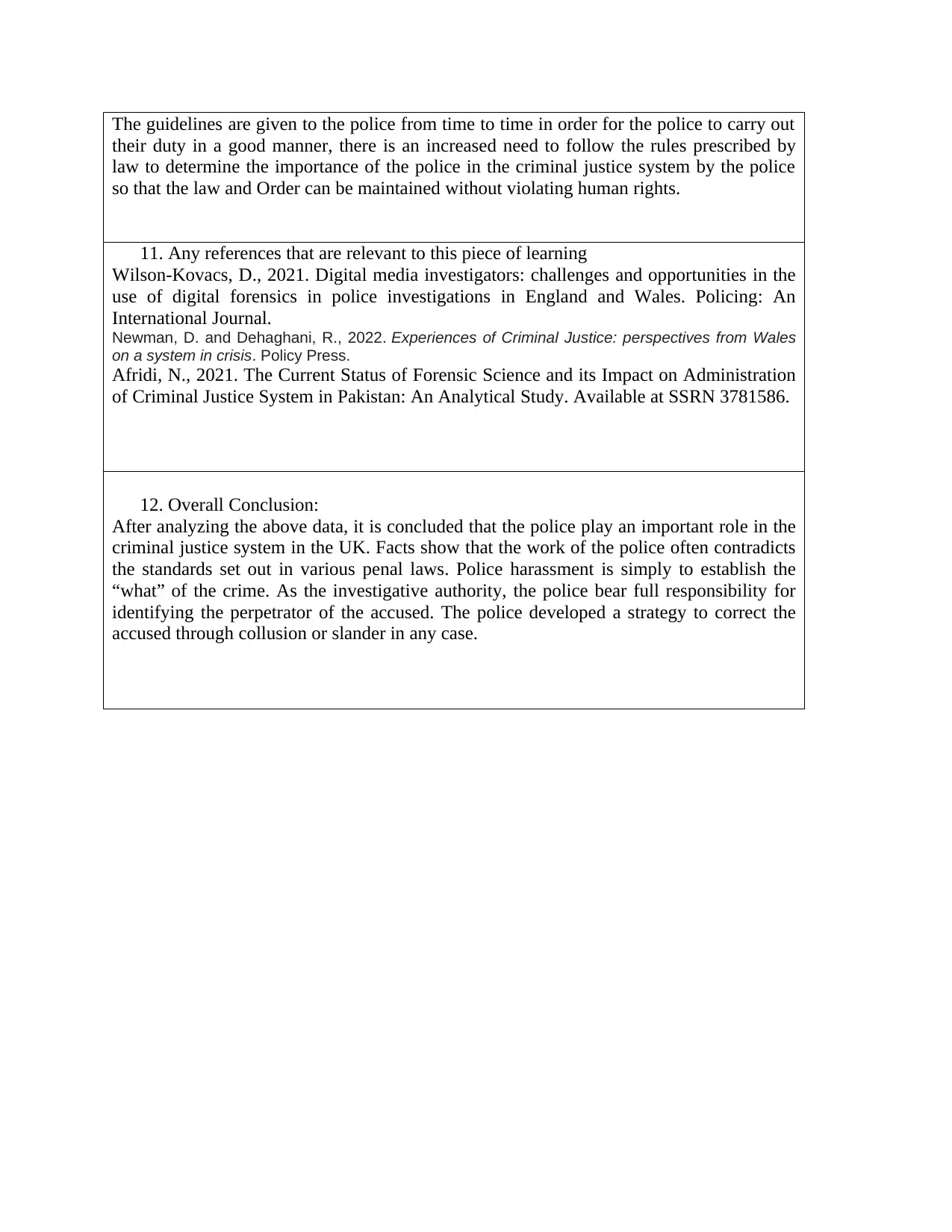
The guidelines are given to the police from time to time in order for the police to carry out
their duty in a good manner, there is an increased need to follow the rules prescribed by
law to determine the importance of the police in the criminal justice system by the police
so that the law and Order can be maintained without violating human rights.
11. Any references that are relevant to this piece of learning
Wilson-Kovacs, D., 2021. Digital media investigators: challenges and opportunities in the
use of digital forensics in police investigations in England and Wales. Policing: An
International Journal.
Newman, D. and Dehaghani, R., 2022. Experiences of Criminal Justice: perspectives from Wales
on a system in crisis. Policy Press.
Afridi, N., 2021. The Current Status of Forensic Science and its Impact on Administration
of Criminal Justice System in Pakistan: An Analytical Study. Available at SSRN 3781586.
12. Overall Conclusion:
After analyzing the above data, it is concluded that the police play an important role in the
criminal justice system in the UK. Facts show that the work of the police often contradicts
the standards set out in various penal laws. Police harassment is simply to establish the
“what” of the crime. As the investigative authority, the police bear full responsibility for
identifying the perpetrator of the accused. The police developed a strategy to correct the
accused through collusion or slander in any case.
their duty in a good manner, there is an increased need to follow the rules prescribed by
law to determine the importance of the police in the criminal justice system by the police
so that the law and Order can be maintained without violating human rights.
11. Any references that are relevant to this piece of learning
Wilson-Kovacs, D., 2021. Digital media investigators: challenges and opportunities in the
use of digital forensics in police investigations in England and Wales. Policing: An
International Journal.
Newman, D. and Dehaghani, R., 2022. Experiences of Criminal Justice: perspectives from Wales
on a system in crisis. Policy Press.
Afridi, N., 2021. The Current Status of Forensic Science and its Impact on Administration
of Criminal Justice System in Pakistan: An Analytical Study. Available at SSRN 3781586.
12. Overall Conclusion:
After analyzing the above data, it is concluded that the police play an important role in the
criminal justice system in the UK. Facts show that the work of the police often contradicts
the standards set out in various penal laws. Police harassment is simply to establish the
“what” of the crime. As the investigative authority, the police bear full responsibility for
identifying the perpetrator of the accused. The police developed a strategy to correct the
accused through collusion or slander in any case.
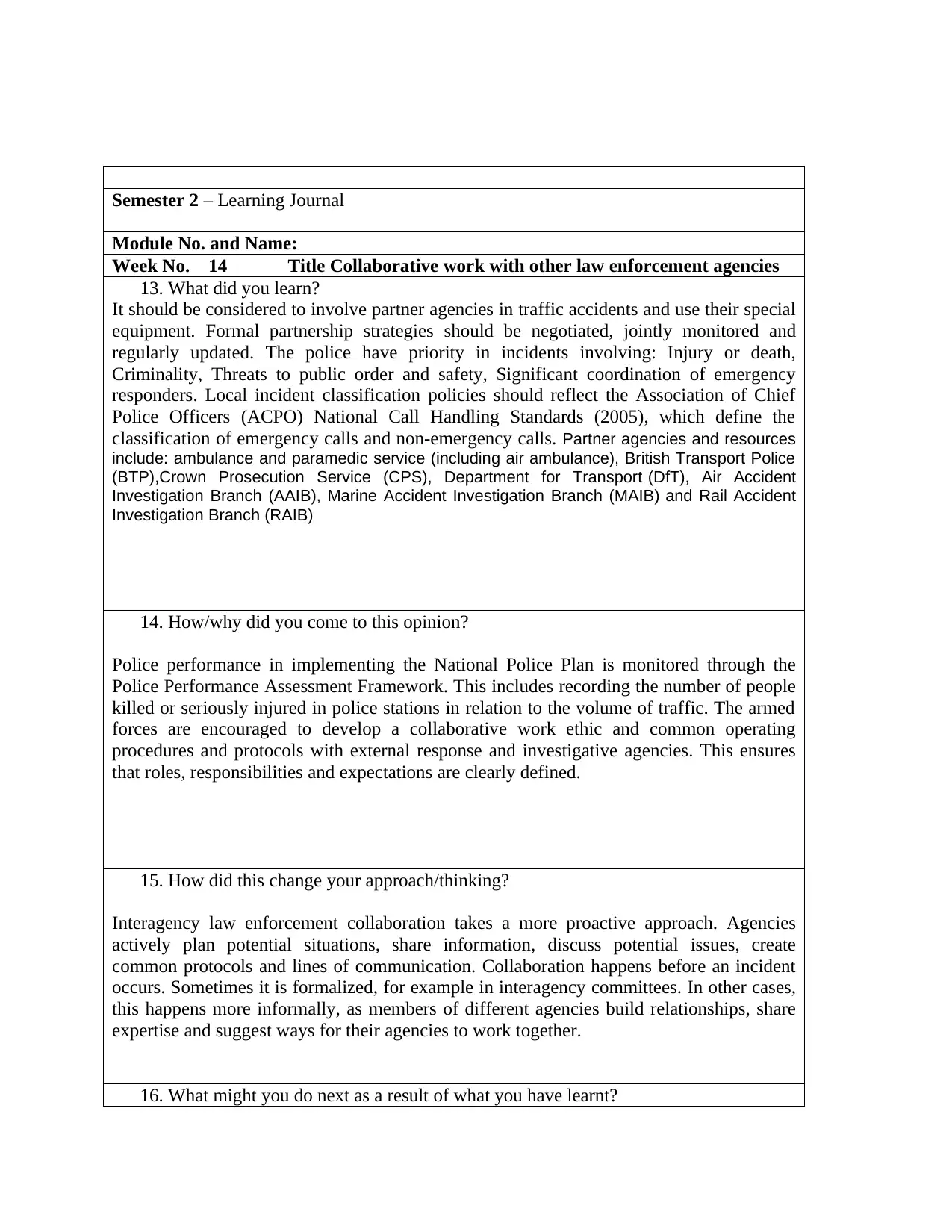
Semester 2 – Learning Journal
Module No. and Name:
Week No. 14 Title Collaborative work with other law enforcement agencies
13. What did you learn?
It should be considered to involve partner agencies in traffic accidents and use their special
equipment. Formal partnership strategies should be negotiated, jointly monitored and
regularly updated. The police have priority in incidents involving: Injury or death,
Criminality, Threats to public order and safety, Significant coordination of emergency
responders. Local incident classification policies should reflect the Association of Chief
Police Officers (ACPO) National Call Handling Standards (2005), which define the
classification of emergency calls and non-emergency calls. Partner agencies and resources
include: ambulance and paramedic service (including air ambulance), British Transport Police
(BTP),Crown Prosecution Service (CPS), Department for Transport (DfT), Air Accident
Investigation Branch (AAIB), Marine Accident Investigation Branch (MAIB) and Rail Accident
Investigation Branch (RAIB)
14. How/why did you come to this opinion?
Police performance in implementing the National Police Plan is monitored through the
Police Performance Assessment Framework. This includes recording the number of people
killed or seriously injured in police stations in relation to the volume of traffic. The armed
forces are encouraged to develop a collaborative work ethic and common operating
procedures and protocols with external response and investigative agencies. This ensures
that roles, responsibilities and expectations are clearly defined.
15. How did this change your approach/thinking?
Interagency law enforcement collaboration takes a more proactive approach. Agencies
actively plan potential situations, share information, discuss potential issues, create
common protocols and lines of communication. Collaboration happens before an incident
occurs. Sometimes it is formalized, for example in interagency committees. In other cases,
this happens more informally, as members of different agencies build relationships, share
expertise and suggest ways for their agencies to work together.
16. What might you do next as a result of what you have learnt?
Module No. and Name:
Week No. 14 Title Collaborative work with other law enforcement agencies
13. What did you learn?
It should be considered to involve partner agencies in traffic accidents and use their special
equipment. Formal partnership strategies should be negotiated, jointly monitored and
regularly updated. The police have priority in incidents involving: Injury or death,
Criminality, Threats to public order and safety, Significant coordination of emergency
responders. Local incident classification policies should reflect the Association of Chief
Police Officers (ACPO) National Call Handling Standards (2005), which define the
classification of emergency calls and non-emergency calls. Partner agencies and resources
include: ambulance and paramedic service (including air ambulance), British Transport Police
(BTP),Crown Prosecution Service (CPS), Department for Transport (DfT), Air Accident
Investigation Branch (AAIB), Marine Accident Investigation Branch (MAIB) and Rail Accident
Investigation Branch (RAIB)
14. How/why did you come to this opinion?
Police performance in implementing the National Police Plan is monitored through the
Police Performance Assessment Framework. This includes recording the number of people
killed or seriously injured in police stations in relation to the volume of traffic. The armed
forces are encouraged to develop a collaborative work ethic and common operating
procedures and protocols with external response and investigative agencies. This ensures
that roles, responsibilities and expectations are clearly defined.
15. How did this change your approach/thinking?
Interagency law enforcement collaboration takes a more proactive approach. Agencies
actively plan potential situations, share information, discuss potential issues, create
common protocols and lines of communication. Collaboration happens before an incident
occurs. Sometimes it is formalized, for example in interagency committees. In other cases,
this happens more informally, as members of different agencies build relationships, share
expertise and suggest ways for their agencies to work together.
16. What might you do next as a result of what you have learnt?
⊘ This is a preview!⊘
Do you want full access?
Subscribe today to unlock all pages.

Trusted by 1+ million students worldwide
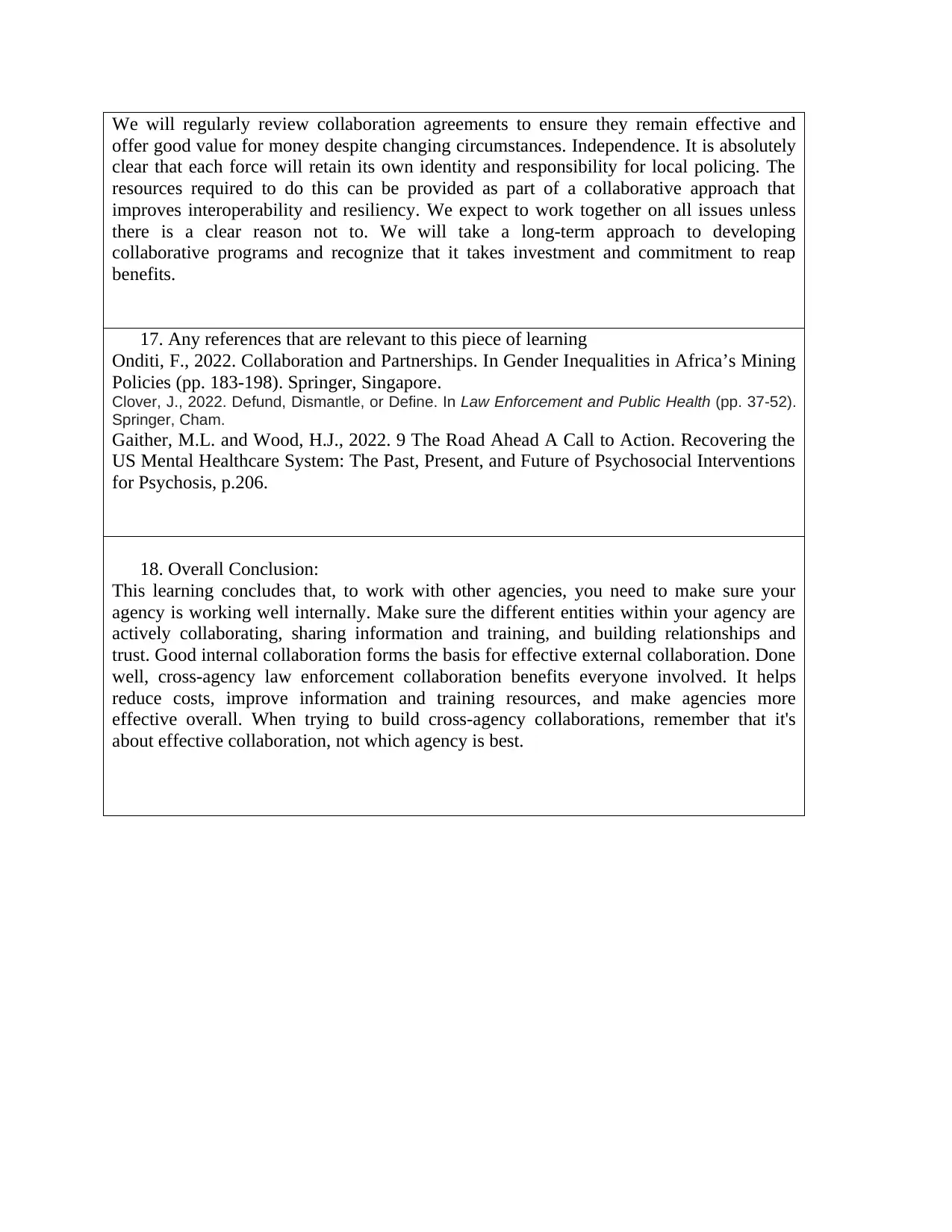
We will regularly review collaboration agreements to ensure they remain effective and
offer good value for money despite changing circumstances. Independence. It is absolutely
clear that each force will retain its own identity and responsibility for local policing. The
resources required to do this can be provided as part of a collaborative approach that
improves interoperability and resiliency. We expect to work together on all issues unless
there is a clear reason not to. We will take a long-term approach to developing
collaborative programs and recognize that it takes investment and commitment to reap
benefits.
17. Any references that are relevant to this piece of learning
Onditi, F., 2022. Collaboration and Partnerships. In Gender Inequalities in Africa’s Mining
Policies (pp. 183-198). Springer, Singapore.
Clover, J., 2022. Defund, Dismantle, or Define. In Law Enforcement and Public Health (pp. 37-52).
Springer, Cham.
Gaither, M.L. and Wood, H.J., 2022. 9 The Road Ahead A Call to Action. Recovering the
US Mental Healthcare System: The Past, Present, and Future of Psychosocial Interventions
for Psychosis, p.206.
18. Overall Conclusion:
This learning concludes that, to work with other agencies, you need to make sure your
agency is working well internally. Make sure the different entities within your agency are
actively collaborating, sharing information and training, and building relationships and
trust. Good internal collaboration forms the basis for effective external collaboration. Done
well, cross-agency law enforcement collaboration benefits everyone involved. It helps
reduce costs, improve information and training resources, and make agencies more
effective overall. When trying to build cross-agency collaborations, remember that it's
about effective collaboration, not which agency is best.
offer good value for money despite changing circumstances. Independence. It is absolutely
clear that each force will retain its own identity and responsibility for local policing. The
resources required to do this can be provided as part of a collaborative approach that
improves interoperability and resiliency. We expect to work together on all issues unless
there is a clear reason not to. We will take a long-term approach to developing
collaborative programs and recognize that it takes investment and commitment to reap
benefits.
17. Any references that are relevant to this piece of learning
Onditi, F., 2022. Collaboration and Partnerships. In Gender Inequalities in Africa’s Mining
Policies (pp. 183-198). Springer, Singapore.
Clover, J., 2022. Defund, Dismantle, or Define. In Law Enforcement and Public Health (pp. 37-52).
Springer, Cham.
Gaither, M.L. and Wood, H.J., 2022. 9 The Road Ahead A Call to Action. Recovering the
US Mental Healthcare System: The Past, Present, and Future of Psychosocial Interventions
for Psychosis, p.206.
18. Overall Conclusion:
This learning concludes that, to work with other agencies, you need to make sure your
agency is working well internally. Make sure the different entities within your agency are
actively collaborating, sharing information and training, and building relationships and
trust. Good internal collaboration forms the basis for effective external collaboration. Done
well, cross-agency law enforcement collaboration benefits everyone involved. It helps
reduce costs, improve information and training resources, and make agencies more
effective overall. When trying to build cross-agency collaborations, remember that it's
about effective collaboration, not which agency is best.
1 out of 7
Related Documents
Your All-in-One AI-Powered Toolkit for Academic Success.
+13062052269
info@desklib.com
Available 24*7 on WhatsApp / Email
![[object Object]](/_next/static/media/star-bottom.7253800d.svg)
Unlock your academic potential
Copyright © 2020–2025 A2Z Services. All Rights Reserved. Developed and managed by ZUCOL.




